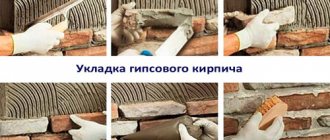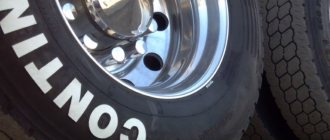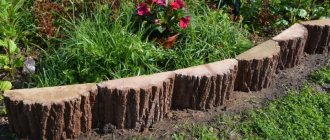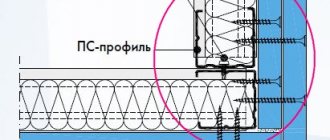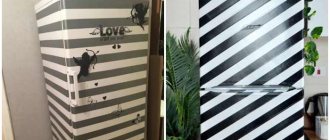The automotive industry is developing, and there are more and more .
They gather dust in garage cooperatives, around tire shops, and in roadside thickets.
But this is a valuable building material.
Summer residents enjoy making beautiful decorative wells for their dachas and gardens from old car tires, decorating the yard and delighting the owners with their unique design.
How to build such a colorful flower well? Instructions are further in the article.
Tire flowerbeds: manufacturing ideas
To create an expressive appearance, a flowerbed needs a border designed to clearly indicate the boundaries of the structure. An unusual solution in this situation is old car tires, which car owners throw into landfills as unnecessary, simply polluting the environment. A product made with your own hands from a used tire will not only help protect the environment, but will also become a spectacular decoration for a flower bed in your garden plot.
Peculiarities
Flower beds made from used tires have many advantages:
Even a consumer with an average income can afford to plant a flowerbed in his summer cottage or under the windows of his house, because worn-out tires do not represent any material value. The used material can probably be found among fellow car owners who dream of getting rid of old tires. For them it is garbage, but for an amateur landscape designer it is the basis of a future masterpiece.
Used tires no longer have their original rigidity, so they can easily be processed. When decorating, a small set of tools is used: chalk, a sharp knife or jigsaw, and a can of paint. The simplest garden structure does not require any processing - the tire is placed on the ground and filled with soil.
The rubber garden accessory is known for its durability: it is not afraid of moisture, does not rot, and is not afraid of bacteria and fungi. The likelihood that it will crack from mechanical shock or severe frost is too small. But even in this case, the situation can be solved - the old tire is easily replaced with another.
A flower bed made from waste tires is a compact, mobile structure that is not difficult to transport and can easily change location. Nothing prevents you from transporting it even to another city, you just have to remove the old soil.
Tires are characterized by the ability to transform. Even unique flower beds, created with love with your own hands, can become boring over time. A simple way to correct the situation is to repaint the product. Using spray paint cans you can endlessly vary the color scheme, constantly changing the surroundings of your garden plot.
A flower bed made from a used wheel is always a win-win option for landscape design. Such material allows you to show creativity, express yourself, and show your artistic potential.
The products have no significant disadvantages. But adherents of classicism do not favor them: some demand something more familiar and elegant, others do not want to waste time on making decorative compositions.
The disadvantages include the flammability of the material, but if fire safety is observed, this fact is not significant.
How can I do it?
To create the simplest flowerbed from an old wheel, you don’t need step-by-step instructions - just pour soil into the tire, and the flowerbed is ready. But even such a trivial thing can be made beautiful, given character and some “flavor” added.
To create an elegant flowerpot from tires, just make leaves or petals of different sizes along the edge:
- To do this, the inner edge of the rubber wheel is cut out in a zigzag or wave shape, then the product is turned out, sanded and coated with the desired paint.
- But first, they mark out the future shape of the flowerbed, applying the ornament with chalk. At this stage, you should give free rein to your imagination and draw any ornament you like.
What to cut with?
After marking the pattern, you need to trim the tire for the future flower bed. This is the most time-consuming part of the job. To do this you will need a sharp knife, jigsaw or grinder. It takes a little longer to cut with a knife, but the grinder melts the rubber and adds an unpleasant aroma.
To increase the glide of the knife blade, you can lubricate it with liquid soap during the cutting process. The use of a jigsaw, which allows you to cut even the most complex shapes, will help greatly facilitate the process.
You can get injured when cutting, so be sure to use special gloves and safety glasses. It is better to work on a hard, wide surface: a stable table or a piece of plywood laid on the ground.
A respirator will save you from the abundance of rubber dust for which Chinese tires are famous.
You need to cut the pattern strictly along the intended line, then the product will turn out smooth and beautiful. The cut out part is not thrown away; it can be used as a base for a stand or a border for a miniature flower garden.
Step-by-step manufacturing instructions
After choosing a location for a sewerage structure made of tires, you should consider what volume will be optimal. Professionals recommend taking into account that the size of the tank should be sufficient to take three times the daily volume of liquid.
If necessary, a tire septic tank can be concreted
Sequence of work:
- For the initial tank, a tire is used, along which it is necessary to mark the dimensions of the well. For the second container, you can use a larger tire, because the second well needs to be made larger. Next, you should dig a hole of the required size.
- The bottom of the well should not allow sewage into the ground. To prevent this, you can make a special clay plug (at least 20 cm wide) with your own hands or concrete the bottom.
- The upper part is carefully removed from the surface of the tire material, so that the structure becomes even. Next, the wheels are stacked on top of each other. To make the structure more durable, it is recommended to tie the tires in pairs. At a height of 2/3 from the bottom, a transition pipe is installed between the wells. And in the first tire a hole is made for the sewer pipe.
- All that remains is to lay and secure the pipe, fill the hole without damaging the integrity of the structure.
Thanks to its low cost and ease of installation, a tire septic tank has earned positive reviews from many owners. Such a structure would be an excellent solution for a summer cottage. However, when constructing it, it is important to carry out installation work correctly and take care of a good drainage system.
I would like to give advice to everyone who needs a cellar-basement, but who cannot build it either due to the lack of free territory, or because for material reasons they are simply not able to build a traditional cellar made of bricks, blocks, or timber.
I don’t recommend making a plank cellar - it won’t last long. My advice is this: don’t be too lazy to travel around collective farm and state farm landfills, where there may be old cylinders from K-700, MTZ-80, T-150 tractors. From these cylinders it is not at all difficult to make a good, fairly spacious, and most importantly, durable basement for your winter preparations.
First, we dig a round hole of the required depth. Then, for all tire cylinders, except one, we cut off one sidewall in a circle, as shown in Fig. 2. We do not touch the second side, this is the future shelf. They start laying cylinders in the pit with cylinders from the K-700 tractor, since they are much heavier and stiffer than others. We orient this cylinder with the remaining sidewall down, then install other cylinders on it one by one until we build the walls of the cellar to the desired height. As already mentioned, we did not cut off the sidewall of one large cylinder. This balloon will crown our structure. And a smaller cylinder (from the T-150) will fall on it, which will act as a hatch.
Personally, I insulate the balloon hatch from the inside with bags of straw, and install a wooden lid on top. Don't forget to also provide ventilation if necessary. To do this, it is enough to cut a hole in the sides of the cylinder hatch and insert a pipe with a diameter of 50 mm there. And here's another tip. To make the cylinders easier to cut, water the cutting area with water. Personally, I was happy with this kind of basement. After all, the side shelf of one cylinder from MTZ-80 - you probably won’t believe me - includes twenty-four 3-liter cans.
Now I’ll tell you about an episode that occurred during the construction of my tire cellar. It perfectly demonstrates how quickly such a cellar can be made. And this is what happened. When I had the pit ready, it started to rain, and quite a good one at that. In a panic, I ran to a friend (he worked on a truck) and with his help brought several needed cylinders. However, there weren’t enough of them, so I went on a tractor to look for the missing ones. I carried out the entire operation of erecting the walls of the basement in the rain, but after just three hours it was already possible to close the lid of the new vault. Many people still don’t believe that everything was done so quickly, but it’s true.
For three years now the cellar has served me faithfully. By the way, there are no rats or mice in such basements; apparently, they don’t like rubber. I do not recommend cementing the bottom. Make the stairs according to your own taste. I personally can do without it altogether. But the basement has one drawback: it is not suitable for fat people - there is not enough space. In a word, try to make a similar basement. You will not regret!
O. Shkorkin, Do It Yourself Magazine No. 5-98.
Basic requirements for building a septic tank
Recommendations during construction:
- This type of septic tank can be installed if the level of groundwater flow is deeper than two meters. This condition guarantees the immobility of the structure when washed away by water, or the preservation of the septic tank body during heaving of the earth.
- This type of sewerage system is suitable for installation on sandy loam soil because it has drainage properties and facilitates quick cleaning.
- Installing a septic tank requires taking into account the level of soil freezing on the site.
- It is necessary to calculate the distance from residential premises, it should be equal to five meters. The septic tank should be twenty meters away from the source of clean water. The treatment plant is located at the lowest level of the site to prevent wastewater from entering the waters flowing underground.
- The septic tank is located higher than the water intake.
- The sewerage system must be provided with free access for vehicles to pump out wastewater.
The advantages of this design:
- does not require cash investment;
- construction takes a little time;
- the opportunity to build a septic tank with your own hands;
- any tires can be used as material;
- simplicity of structure.
The disadvantages of the design include:
- low level of productivity;
- The wear life of the septic tank is fifteen years;
- smells from the septic tank;
- Accidental leakage of the seal will lead to soil contamination.
What to consider before starting construction
If the height of the pit exceeds five meters, you must obtain permission from specialists to install a septic tank. If the documents for land surveying are in order, then obtaining permission is easy. All standards are specified in the Code of Land Law of the Russian Federation. If the documents were received before 2014, then you will need to redo the passport for the site. The cost of this procedure is approximately six thousand rubles.
If there is a cable on the site that provides communication, then you need to get permission from the owner. To do this, they call a specialist with a metal detector to determine the place where digging is prohibited.
Drainage system at a summer cottage, organization rules
Drainage is needed: instead of beds - a lake
The easiest way to remove excess moisture is to make several drainage branches from scrap materials with output to a receiver. For work, it is better to choose a period when the amount of precipitation and groundwater level are at a minimum: in summer or early autumn. And it is necessary to plan the drainage layout during the season of heavy rains or melting snow - in the spring.
Bad timing: work stopped due to rain
In addition to draining the soil, properly laid drainage from old tires can solve several problems:
Stop the process of erosion of the top fertile soil layer.
Reduce the moisture level in the deep layers of the soil.
Drain streams of rainwater from the beds.
Prevent diseases of trees and ornamental plants.
In order for the system to work properly, it is necessary to correctly select the trajectories of the drainage lines, determine the depth and location of the drain. The simplest method is observation.
During a rainstorm, pay attention to the direction of flows - natural flow lines will help determine the correct lines for drainage channels
A simple wiring diagram for country drainage
When planning the system, the topography of the site is taken into account: the branches are positioned so that the beginning of the trench is at the highest point, and the drainage is at the lowest point. In addition to linear outlets, it makes sense to install point water intakes. It makes sense to install collection points in small natural depressions where water stagnates - setting up point drainage from tires will take less time.
To correctly determine the depth, you need a simple analysis of the soil condition. If the groundwater level is constantly high and the rock is heavy and has low permeability, you will have to dig deep trenches:
Up to 1 meter deep in the area where fruit trees are planted.
Up to 70 cm - in places where beds are arranged.
Up to 50 cm - along the perimeter of the site, along the paths.
Channels dug to a depth of more than half a meter are considered deep. Trenches for adjusting the groundwater level are equipped with a drainage casing: a perforated pipe covered with crushed stone and a geotextile wrap. You can replace purchased materials with improvised means:
Instead of ready-made pipes - tires
Old tires of different diameters will serve as a drainage pipe.
Instead of crushed stone, broken old bricks, pebbles, expanded clay, and pieces of foam sheets are used.
It is advisable not to skimp on geotextiles: the fabric will protect drainage from silting and destruction by dense clay.
Surface channels up to 50 cm deep are left open or equipped with a cage in the same way as deep trenches. Instead of solid wheels, pieces (segments) of tires are installed as a pipe. Backfill materials needed for drainage are sand and crushed stone.
The moisture flowing down the drainage channels must be removed from the area to be drained and a drainage point must be organized. If there is a pond or roadside ditch nearby, then water can be discharged without constructing a drainage well. On the site itself, drainage receivers are installed - containers without a bottom, installed on a gravel or crushed stone bed. After draining into the well, water from the canals is additionally purified by a backfill filter and discharged into the ground.
There are several options for arranging the walls of a drainage well:
Ready-made plastic or concrete products.
Factory plastic tank
Homemade drainage wells. Materials for assembly - tires or old plastic barrels, bricks.
Homemade drainage receiver
On rocks oversaturated with moisture, installing a single drainage tank may not be enough. To discharge large volumes of water, especially if there is a septic tank on the site, a drainage field is equipped: an area with a drainage tunnel for drainage. The tunnels are made of plastic in the form of hemispherical channels, reminiscent of a pipe cut lengthwise. You can also make your own channel from large diameter tires.
Tire flowerbed
Those who want to improve their front garden will immediately have a question: how to make a flowerbed from a tire with your own hands so that it is beautiful? The easiest option to avoid cutting the tire is to lay out a shape from whole tires or make a multi-tiered structure. Use paint to create an interesting pattern or color concept.
More complex options require some processing. To make a shaped flower bed from a tire, you will need the following tools:
- a shoemaker's knife, which makes the first cut;
- jigsaw - for curly processing of sidewalls;
- grinder or metal scissors - for cutting metal cord.
Procedure for making a flower bed from tires:
- Apply markings to the body of the tire along which cutting will be carried out. To do this, you can use chalk or a bright marker.
- Cut out the required shape.
- If some parts need to bend, then the rubber is fixed to the wire to keep its shape.
- If necessary, sand the edges of the cuts using sandpaper or a file.
- Color the product according to your design.
If you have the necessary tools and materials at hand, you can get the job done quickly and efficiently.
Rubber flower bed projects
An old wheel can be used to implement various ideas. Examples of flower beds made from tires include the following compositions:
- Vertical flowerpot for decorating brick walls and fences. A small tire can be painted any color and hung vertically from the wall. Small flowerpots with flowers are placed inside.
- Seven-flowered flower. Paint 4 tires in different colors. Cut 3 tires in half and leave 1 whole. Place a whole tire in the center, and place the remaining halves around it in a circle, forming petals.
- Toad. You need three large diameter tires and two smaller ones, painted green. Place two tires side by side and place a third on top. Install two small tires perpendicularly, which will be the eyes.
- Rubber turf. You need to take 2 large tires and 1 smaller diameter. On a large tire, make markings in the form of small teeth. Cut the cloves according to the markings. Lay the whole large tire on the ground, put the smaller one on top, and place the figured tire at the very top. To make the flowerpot taller, you can use several small tires.
Any idea can be made from this material. It is possible for children to create a fairy meadow by making interesting compositions from rubber blanks.
Ways to color a flower bed
To achieve a good result and create an original decoration for a flower garden, you need not only to do a high-quality job of cutting rubber, but also to paint the craft.
If you choose the right combination of colors and shades, the flower garden will sparkle with new colors. Each flower, blade of grass and leaf in the flowerbed will stand out against the general background of the structure.
Recommendations regarding coloring:
- The product must be painted on the outside and inside to create the effect of structural integrity.
- In order for the drawing to turn out clear and bright, you need to create a foundation. Therefore, first the surface is painted with a thin layer of white paint.
- Rubber must first be degreased with acetone or solvent.
- The paint should be bright, preferably moisture-resistant, since flower beds require constant watering.
- The product requires updating. Once a season you need to tint the flowerbed.
The most popular coloring flower 5 petals for cutting:
- Apply markings to the tire.
- Cut out the petals according to the diagram.
- Turn out the protruding parts to bend each element.
- Color each petal. You can use different colors.
The main thing is not only to choose a beautiful pattern or motif, but also to do the coloring work efficiently and accurately. Some craftsmen create entire masterpieces and themed front gardens, skillfully wielding a brush.
Features and advantages of the material
Car tires for cars and some trucks are excellent and inexpensive material. For motorists, tires are usually replaced once every 4-5 years, depending on the degree of tread wear. And at this moment, once very expensive and fashionable tires become a headache. You need to store it somewhere, and suddenly you need it! It can be scrapped, but you need to find a collection point and pay extra. Or you can sell it, but who will buy it? So it turns out that at any car service or tire shop there are a huge number of such tires, completely free of charge!
Well, if so, then you can not only take the required quantity, but also select tires by size. Yes, tires have their own sizes and this is important for building a well with your own hands. In order for it to turn out smooth, without distortions and to look good from the first minute, you should select it according to two parameters - the size of the rim in inches and the tread width. The markings on the tires indicate three main indicators; they go through a fraction, for example, 195\65 R15. The first number indicates the width of the tire on the tread. The second shows the profile height from the rim to the tread. The third alphanumeric designation shows the diameter of the rim.
For a well, you need to select tires with approximately the same indicators, or at least close to each other.
But in order to get a beautiful pattern, you need to select the type - summer or winter. The summer one usually has a larger pattern, but it has longitudinal lines or water drainage lines. But on a winter one, the pattern is smaller, but it is usually not so visible, the material itself is softer in structure and wears out faster on wheels.
Advice! Pay attention to tires for SUVs or SUVs; they have a brutal and terrifying pattern and when painting, it is possible to separate the surface with color.
When choosing a material for work, you need to carefully check the outer side of the tire, running your hand along the tread and sides, you need to determine whether there is a protruding cord - the metal base of the tire. A torn cord with steel threads protruding outward can scratch the skin, which will be extremely unpleasant, so you need to choose a material without flaws.
Flower beds and flower beds made from tires
Let's start with, perhaps, the simplest flower beds and flower beds. Do you think making a multi-tiered flower bed is difficult? Maybe, but not from tires. Take several pieces of different sizes, paint them in bright colors and stack them in a pile - one on top of the other. To prevent your slide from falling apart, fasten the tires from the inside using a screwdriver and self-tapping screws. Two per connection will be enough. You fill the soil inside and plant the plants. To prevent the soil from spilling out, you can cover the inside of the tire with a piece of geotextile. It will remove excess water, but will not allow the soil to spill out. A beautiful tiered flower garden is ready.
Tiered flower bed made of tires
If you like regular shaped flower beds, you can make these too. For example, making a flower bed in the shape of a chamomile out of tires. First, the tires in the lower tier are laid out and fastened together. Fill the middle of the tires with earth, as well as the free space inside the circle. For better drainage, you can place broken bricks or other construction debris there, sprinkle a little earth on top and compact it. On the prepared surface, stepping back from the edge by more than half the diameter of the tire, lay out the second tier. They are also fastened together, the middle is covered with soil, and the core is placed on top. You can plant tall flowers at the very top, and border or low-growing flowers on the lower tiers.
Another way to make a tiered flower bed from tires
Another option for a flowerbed made of tires in the shape of a chamomile - in one tier. To do this you will have to cut the tires.
Daisy flower bed made from tires
Choosing where to dig a hole
The well accumulates water not only from the lower layers, but also from shallow horizons. Water enters the soil from the surface, undergoing natural filtration. Before you dig, think about whether there are harmful industries nearby? Chemicals and waste products end up in the water and you should not drink it. You can first take a water sample and conduct research at the sanitary-epidemiological station. Price for analysis from 700 rub.
Next, we contact the local geological exploration station. Maps are stored there that show the geodesy features of your area or city. It will be easier to find water on the site.
The second important point is that the structure must be positioned so that there is at least 20 m to the restroom and the place where animals are kept. You can find a good place on the site using the old-fashioned method. Take the willow twigs and cross them to form a frame - a triangle. Walk around the area, the willow will show you where the best place is.
Construction of the simplest well
Scheme for creating a well for a decorative well Cut holes in each of the 3 tires for the support posts on which the roof will be located. Try to make the sipes at the same level on all three tires. Place the first tire on the ground and make marks on the soil. In the marked place you need to drill a small hole for the support posts. For additional fixation of tires, the base for the pegs can be concreted.
Step two - making the roof. In order for a decorative well to have an attractive appearance, you need to take measurements of the stakes driven into the ground. We cut off the irregularities with a hacksaw. It is better to make a cover for a homemade tire well from a special roofing material (can be used).
Instructions for constructing a roof:
- Construction of roof supports. Between the wooden beams you can build with your own hands something similar to gratings or crossbars;
- We make the flooring from slate or boards. This is the most suitable option for a tire well. Metal tiles, ceramic tiles, bituminous shingles or roofing felt are also considered good roofing materials for the roof. Note that the shape of the roof can be gable or single-pitch - it all depends on your preferences and ability to make complex structures with your own hands.
Roof diagram for a well
Why are drainage wells needed?
At its core, drainage is a set of hydraulic engineering measures to protect structures and land from the effects of excess moisture formed due to precipitation, floods, seasonal increases in groundwater levels, etc. Any, even the most durable structures begin to gradually collapse if unplanned water undermines the foundation. Fertile lands that are flooded with water for a long time will simply lose all their best qualities.
These circumstances lead to the need to protect buildings and your site from dangerous influences, especially in areas with high natural humidity. For this purpose, a special drainage system is manufactured that solves specific problems: collection, drainage, removal and disposal of excess water mass. Such systems are created with your own hands, but taking into account the recommendations of specialists.
Structurally, drainage complexes include the following components:
- Water intake elements. They are placed directly in the flood zone and can be formed in the form of trenches, to which pipe drains are connected.
- Main elements: pipeline (drains) or trench system for water drainage.
- Recycling elements. This part completes the process, that is, it performs the final operation: storing water or discharging it into the soil in a safe place.
- Additional operational elements. These include control and shut-off devices, devices and structures for operating and repairing the system.
The drainage well is considered an important part of the entire drainage system. It can perform recycling functions (the main task) or play the role of an additional operational element. The operation and efficiency of the entire system depend on the reliability and correctness of its installation. In particular, its volume must allow the collection of all drained water, otherwise the drainage simply will not provide the required drainage.
Pros and cons of tire wells
In fact, tires are used to construct various types of wells, but sewage devices are the most popular. The reason for this is the characteristics of the tires and the properties of the rubber itself.
- Low cost is the most important factor when choosing a material. To build a well, you need old, worn-out tires, and these can be purchased at a tire shop at a low price, asked from friends or neighbors, or found on the street.
- The average service life of a tire well is 15–20 years, which is quite a long time. The decorative option will last even longer.
- When the soil swells or moderately moves, a well made from wheels is not damaged by hand, since the elasticity of the material allows the latter to tolerate slight deformations without loss of quality. However, with strong movements, the tightness of the structure is broken. Therefore, it should be checked twice a year and the seams sealed.
- The construction of any kind of tires is done with your own hands. This reduces the cost of equipping a summer cottage. In addition, the tires have the same dimensions and shape, which makes it easy to calculate the required quantity and lay it down correctly.
Of course, this type of structure also has disadvantages.
- It is impossible to repair such a septic tank or drainage; it is necessary to completely replace the structure.
- Rubber is exposed to aggressive environments. Over time, the material dissolves and a not-so-pleasant rubber smell appears.
- It is possible to build decks made of tires only in cases where the depth of groundwater is at least 5 m.
Important! The depth of the shaft is usually 2.5–3 m. This is enough for a septic tank or well with process water as an emergency supply
The depth of a real well with drinking water reaches 9 m. In this case, tires can also be used, but the structure should be strengthened to prevent the walls from collapsing.
How to choose a place
The wastewater tank should not be located next to the source of water supply: well, borehole, deep-well pump.
The infection from it will seep into groundwater and contaminate the drinking source with pathogenic bacteria.
It is also prohibited to equip it in the immediate vicinity of the foundation of a house, bathhouse, or barn.
The soil will settle, the foundation will sink and lead to the destruction of the structure.
It is also not a good idea to place the pit too far from the house. This will lead to a significant increase in the cost of the entire system. Along the entire length of the sewer pipe, it will be necessary to install at least two inspection wells with hatches. Laying too long a pipeline from the house to the septic tank is fraught with blockages.
The optimal length of the drain pipe should be considered 5-10 meters. The slope should be 0.5 meters per 10 meters of pipeline length.
The diameter of the pipe, preferably made of plastic, should be at least 50 cm.
When connecting a drain pipe to a house sewer, you should not lay it under the foundation. It is best to use a crowbar, hammer drill, or jackhammer to punch out a special niche in the upper part of the foundation into which to insert the pipeline, sealing the cracks with cement mortar.
There are three design options for a septic tank:
- with a filtration system;
- with settling tank and absorption well;
- with filter system and drainage pipeline.
We choose a budget option - with a filter system.
Tire flower beds: original ideas
People's imagination is limitless, and the pliable rubber of old tires and their comfortable round shape allow this imagination and ingenuity to create unusual and funny, yet comfortable, flower beds from black rubber donuts in the form of:
- flowers;
- cups and teapot;
- swans and parrots;
- frogs and turtles.
You can make flowerpots from tires with your own hands. An arrangement of flowerpots in the form of a tea set creates a pleasant and cute picture without requiring much effort. There is no need to cut or turn out the tires, just place tires of different diameters on top of each other - three for a teapot, two for a cup. In the case of a teapot, the largest one is placed at the bottom, the middle one is at the top, and the small tire is in the middle. In the cup, the smaller diameter tire goes down, the larger one goes up. With the saucer option, everything is a little more complicated: you will need a truck tire, from which the sidewalls are cut off along the very edge with the tread. These side parts installed in will be the saucers.
Note! The spout for the teapot, handles for it and cups are made from scraps of tires or pipes, drains.
Turtle
From the tire and the tread of the second tire you can build a flowerbed in the shape of a turtle, as in the photo. Here are the step-by-step instructions:
- one tire is cut, separating the tread from the side parts;
- the tread is cut into four equal parts, they will be paws;
- in the second tire, two cuts are made symmetrically on both halves under these “paws”;
- pieces of tread in the form of paws are inserted into these holes and fixed to the tire - the “body” using staples or self-tapping screws;
- the tail is made from a piece of rubber and fixed there using the same method;
- a plastic bottle is used as the neck and head;
- Finally, all the elements of the flowerbed are painted in the required colors; a mouth, eyes and nose are drawn on the head.
Flower
A large flower bed in the form of a flower will require approximately the same amount of effort. Four tires are used to decorate the composition. Three of them are cut in half, each half will become a petal. The whole tire will be the center of the flower. Flowerbed elements are painted in various positive colors.
After that, they are buried a few centimeters deep and laid in the shape of a flower: the whole tire in the center, the halves at some distance from it in a circle, one to the other, with the treads facing out. It turns out to be a kind of chamomile.
Swan
One of the most popular and at the same time complex options for a do-it-yourself tire flower bed is a decorative swan. The main point in its manufacture is applying certain markings to the tire so that when cut, specific parts of it will form wings, a tail, a neck and a head. Accordingly, careful and precise cutting is required. After cutting, the tire still needs to be turned out.
The creation of the swan is completed by fixing the neck in a curved position using wire and attaching a beak made separately from rubber.
Parrot
One of the most interesting and beautiful options for flowerpots made from tires is a hanging flowerpot in the shape of a parrot. You can try to make it using the following instructions:
- the tire is divided into three equal parts with chalk;
- In one part, the sidewalls are cut out along the border with the tread so that after all there is a tread and the inner edges of the sidewalls in the form of two arches;
- then they turn the cut tire inside out: whole parts turn into the body of a parrot, and the free tread into the tail;
- a beak is formed from cut rubber;
- the edge of the tire in the part where the “body” should meet the head is cut to the size of the beak;
- then the blank for the beak is inserted into this cut, clamped between the flaps of the cut, a hole is drilled through the flaps and the “beak” between them;
- a bolt is inserted into the hole onto the washers and tightened - the head of the bolt becomes the bird's eye;
- a tail is cut out from the hanging free protector;
- the arms above the “body” are pulled together into one handle, from which they will hang;
- They finish the job by painting the parrot in bright colors.
Flower beds in the country: ideas for decorating a flower bed with your own hands Flower beds are an integral part of any site.
Caring owners make them with their own hands. To do this, you need to determine... This is how you can skillfully give old tires a second life. Now they will decorate your garden, and this requires a little effort.
Paint selection
The most crucial moment is the selection of dyes. Oil-based dyes adhere well to rubber, but this coating will not last long. External factors have an impact:
- temperature changes;
- exposure to bright sun;
- severe frost;
- snow, rain, wind, hail.
In a maximum of a year, a well covered with oil paint will have to be repainted.
For greater stability of the coating on tires, you should choose other paints: bitumen, acrylic or enamel.
An excellent option is rubber paint.
This substance does not consist of rubber in the usual sense, as the name says. But the paint is created in such a way that, together with the surface of the tires, it can stretch and shrink.
In winter, the wheels are affected by frost, in summer - by the scorching sun, but the rubber paint does not crack or become deformed.
In addition to washing and drying the rubber surfaces, oil stains should be carefully removed. It is better to do this using special chemical solvents.
Flowerpot from a wheel: turning the tires out
If you have a tire with an old rim, you can use it to make a flowerpot with a leg.
Flowerpot from an old car wheel
To do this, cut one sidewall along the tread. And they turn it inside out. This is not an easy task: considerable physical strength and perseverance are required. The rubber is elastic and it is impossible to turn it out the first time. If absolutely not possible, notches are made on the outside side across the tread. They should be quite deep, but not through. It will also help if you make cuts along the edge with a depth of at least 5-7 centimeters. They will look like fringe on an inverted tire.
Why do they turn it inside out? The inner surface is smoother, and the shape can be more interesting, especially if the edge is made not linear, but jagged. The result will be a gracefully bent decoration.
Another option for a flowerpot made of tires
For details on how to turn out a tire, watch the video.
In a similar way, you can turn out a tire without a rim. The sequence of actions is the same. First, cut off one of the sidewalls - straight or zigzag. To ensure that the “petals” are even, it is advisable to mark them. It is convenient to do this with chalk. The mark is then cut with a jigsaw or knife (if the cord is synthetic).
The process of turning an old tire into a flower garden
They turn it out like this: step on the inside of the tire, grab the edge with your hands and pull it up and towards you.
It is important to achieve the first result: when at least some part is bent. If the tire looks like the photo below, it's already a success.
It is developed by successively turning the edge inside out and standing on the already turned part so that it does not turn back.
Removing the tire without the rim
Watch the process again in the video. This time they turn out the tire without the wheel (they cut it, by the way, with a knife).
Even by itself, such a tire turned inside out looks good. If you paint it, it becomes even better. If desired, they can be combined - different colors, sizes, installed differently: on a tire or on legs.
Installation options
A tall flower bed always looks beautiful. Especially with hanging plants. It can also be made from tires, and there are several possibilities. The photo below shows two ways to secure cut tires at different levels. The first is to use stumps for this, to which flowerpots are attached with nails or screws. The second is to use reinforcement - three or four rods on which to put rubber. Having set the tier at the desired level, it needs to be secured; on metal this can only be done with the help of clamps.
Multi-tiered raised flower beds made from tires
It is not always possible to place a flowerpot on the ground: some areas are so developed that it is problematic to allocate even one square meter. For this occasion, people came up with various hanging flowerpots, also made from old tires. Only a small part of the whole tire remains, so you have to cut a lot... be patient. For example, you can make hanging flowerpots in the shape of a dolphin, parrot, rooster and other strange birds. For some ideas, see the photos.
Tire planter - parrot, rooster and dolphin
All these crafts made from tires. Only a small part of them - the heads - are often made of dense foam. Having cut and sanded the part of the desired shape, it is attached using self-tapping screws coated with glue (this is a secret, remember), and then painted. Watch the video to see how to make a parrot from a tire.
From a cut tire you can make a garden path that will last for many years.
Which wells are included in the system
When providing drainage with your own hands, the following types of drainage wells are provided:
- Rotary option. Such wells are installed with an extended pipeline at the following points: through one turn of the pipe and in the place where several pipes converge into one line. The problem to be solved is cleaning the pipes (drains), since dirt plugs often occur in bend areas.
- Absorption type. These structures do not require prefabricated or main elements. They are dug at different points where water accumulates, which itself flows into wells. When installing such structures, it is important to form a surface slope so that moisture flows into them on its own.
- Water intake wells. At their core, these are sealed containers into which all collected moisture flows through drains. As they fill, water is pumped out or used for technical needs, for example, for irrigation.
- Filter structures are the final element of the drainage system, located in a remote area where water can be discharged into the ground. In principle, this is a variant of a water intake well, in which the bottom is not sealed, but is made in the form of a natural filter. Water seeps into the ground through the bottom zone.
The design of drainage wells depends on the task being performed, with this difference mainly due to the structure of the bottom area. The bottom can be arranged in two ways: be sealed in the form of concrete pouring or non-sealed, based on a cushion of sand and crushed stone. The well shaft has a depth sufficient to accumulate the required volume of water.
Most often, it is 3-5 m. The shaft wall must have waterproofing to prevent the collected moisture from seeping into the upper layers of the soil. Finally, the top plate and hatch complete the structure. In production wells, a ladder is installed inside the shaft.
How is a septic tank different from a cesspool?
A cesspool, unlike a septic tank, is not a complex system of wastewater, it is a storage tank for them. A septic tank is often part of a sewer system. The cesspool makes it difficult to drain waste into the ground.
To understand how a septic tank differs from a cesspool, you need to accurately and clearly understand the principles of the design and operation of each of the storage tanks
A septic tank may have a number of advantages compared to a cesspool, namely:
- A septic tank may consist of two or three tanks;
- Using a septic tank, the need to frequently call sewer trucks is reduced;
- Useful for those who often visit the dacha;
- Less impact on the environment, unlike a cesspool.
Work technology
A well made from old tires requires a creative approach, rich imagination and free time.
A homemade decorative well from scrap materials is an excellent way to decorate your garden plot. However, not every summer resident can afford stone and wood products. An excellent alternative would be old car tires.
To make a decorative well you will need the following materials and tools:
- worn-out car tires – 2–3 pcs.;
- gravel and large stones;
- sand and black soil;
- flowering ornamental plants in pots;
- wooden beams for making racks;
- roofing material;
- self-tapping screws, screws, nails, bolts and washers for them, metal corners and other fasteners;
- building level, metal tape measure, marker;
- screwdriver, drill, hammer;
- sharp knife, hacksaw for wood or metal;
- sand, cement and water for mixing mortar, shovel and bucket;
- paint and tools for applying it.
Don't forget about the main material
Preparing the site and materials
Step-by-step instructions for making a homemade decorative well begin with choosing the location for installing the object and preparing the materials. So, let's determine the location where the well will be installed. It is advisable that the site be protected from the sun and gusty winds. This could be a flower bed or a small front garden.
The selected area of the garden must be cleared of stones, broken branches and various debris. Mark the circle according to the wheel diameter. Dig and compact the site, check the evenness of the surface with a building level. Clean old tires from dust and debris, wash and dry thoroughly. Treat wooden support posts with antiseptics and fire retardants, which increase the fire resistance of the structure. Select the material for the roof sheathing and cut it.
Strengthening
Upon completion of the preparatory work, you can begin making the base of the decorative well:
- Select tires of the same diameter, width and tread pattern.
- Make holes for supports.
- Connect car tires together. It is recommended to use bolts or screws as fasteners.
- Insert the wooden beams into the holes that will be used to assemble the roof frame.
- Place the base in a permanent place. Fill the interior space with rocks and gravel.
- Place a layer of fertile and nutritious soil on top.
Roof
The next step is to secure the supports and assemble the roof. First you need to connect the wooden beams with a crossbar. Then the roof frame is formed and installed on the supports. As roofing material, you can use metal tiles, polycarbonate sheets, wooden boards and slats, sheets of plywood, taken from car wheels and tires cut into long strips, slate, etc.
Final decor
Worn tires themselves don't look very attractive. To give the design an aesthetic appeal, some modification will be required.
First of all, you need to work with the base of the structure. Wash the surface of the tires well with water and liquid soap. When the rubber dries, you need to degrease it with solvent, acetone, gasoline or white spirit.
https://youtube.com/watch?v=nYFd_eJsGkw
Now let's start painting the surface. To apply the base color, it is recommended to use a spray gun or roller. Painting a rubber surface with a regular brush is not advisable, since the paint will not apply evenly. When the base coat has dried, you can add decorative elements to the design. Decor in the form of brick or stonework will look beautiful. A similar pattern is made on the roof. Pots with climbing and flowering crops are installed inside the well, or flowers are planted.
A decorative well made from car tires will become a real decoration of your garden plot. With the help of these instructions, you can decorate your dacha yourself with various crafts made from car tires.
Components of a well-bed for flowers
Country craftsmen always use various available materials .
In action are:
- exotic driftwood;
- sleeper trims;
- old baths;
- trough;
- wooden crafts;
- disused building materials.
To build a decorative well for a garden or cottage, you must prepare the following elements in advance:
- a set of old tires - four tires of the same diameter;
- small round logs
- four smaller wooden blocks to build a roof on top of the well;
- roof covering : slate, tiles, sheet iron, rubber plates, multi-colored plastic - whatever comes to hand;
- fasteners : screws, steel angles, nails, self-tapping screws;
- paint suitable for rubber;
- container for planting flowers and climbing plants.
You can take not four tires, but less - it all depends on the desired height of the decorative well.
When the preparation is completed and all materials have been collected, you can begin to build the well itself.
It’s good to involve all your relatives, children, and neighbors in this exciting process. Together and cheerfully, all the work can be completed in one day.
What plants are suitable for rock gardens
When choosing plants for a rock garden, attention is paid to:
- demand for care. It is advisable to choose plants that require minimal care;
- compatibility with each other;
- high decorative qualities throughout the warm period;
- plant height. Here, tall plants are planted in the background, medium-sized and low-growing ones (ground cover).
A good choice for a slide would be:
- conifers (cypresses, junipers, thujas). They will decorate the composition with their emerald-blue shades;
- ornamental shrubs such as rosemary, cotoneaster, Erica;
- bulbous: tulips, daffodils;
- cereals: fescue, evergreen oats, haretail;
- ground cover: thyme, sedum, periwinkle.
Features of the structure
It’s quite easy to make a well from tires at your dacha with your own hands. Almost everyone can handle this. In the process of designing such an object you will need to use your imagination. Since such a well is an exclusively decorative object, it must fit harmoniously into the overall appearance of the site of a country house.
It is impractical to extract water from such a well. But using it as a flower bed will be more than appropriate. The bright design of the well will highlight the beauty of garden flowers. At the same time, choosing a place to install the structure will not be difficult.
Every car owner also has the material for construction. Old tires are used to create many sculptures. A well is one of the simplest types of decorative landscape art.
Options and principles for making a decorative well
A tire well in a dacha is based on a base of tires, with posts on which the roof and gate are attached. The second option is similar, only instead of a house you can use a “crane” in the form of a swinging bar. As you can see, there are enough options to get started.
The base is assembled from tires. Outwardly, it looks like a children's pyramid, only the rings here are not narrowed, but the same. During work, you can connect the tires together with ordinary wood screws, since rubber is a soft and pliable material. But the installation of the superstructure under the gate and roof or under the “crane” needs to be made durable.
For a playground, it is recommended to first assemble the structure completely, and then remove the mounting screws so that the child does not get hurt. The structure itself can be fixed with bolts, this will be both stronger and more reliable.
For a portable structure that will be used as a container for storing tools and garden supplies, it is reasonable to make a bottom. If the figure will be used as a decorative element, you don’t have to make a bottom, it will even be more convenient - rainwater and moisture from melting snow will go straight into the ground.
